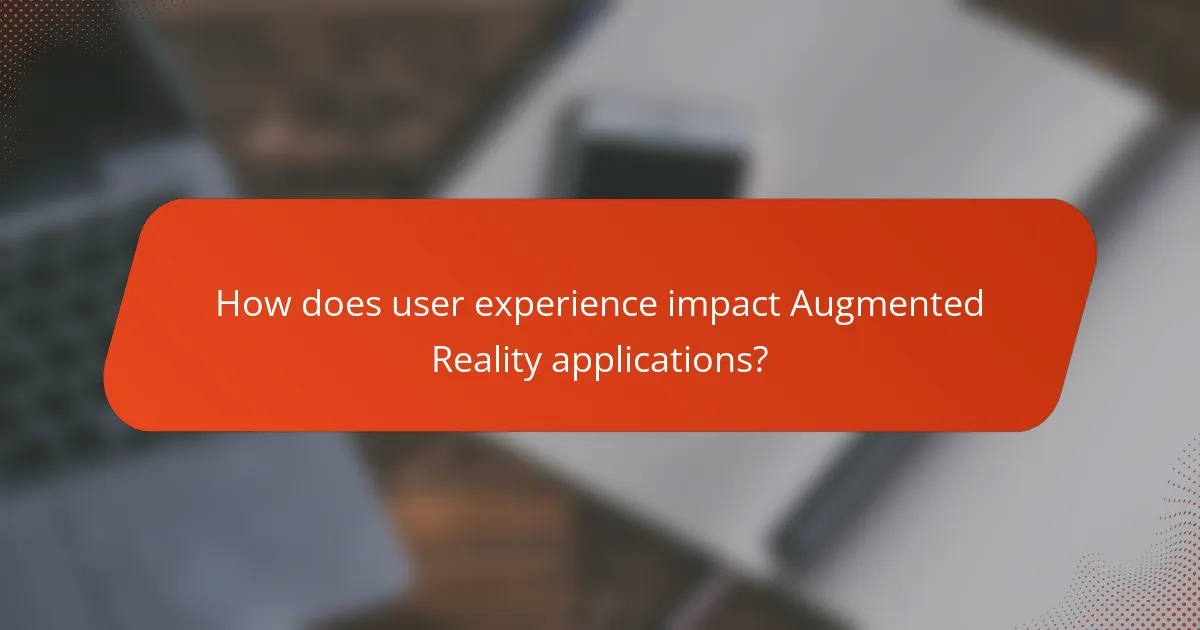Augmented Reality (AR) is a transformative technology that integrates digital information with the real world, significantly impacting various sectors such as retail, education, and healthcare. Current trends highlight the use of AR for virtual try-ons in retail, immersive learning experiences in education, and enhanced surgical training in healthcare. The global AR market is expected to grow substantially, reaching approximately $198 billion by 2025, driven by advancements in mobile applications and hardware. User experience plays a crucial role in the success of AR applications, with intuitive design and immersive interactions leading to higher user engagement and satisfaction. This article explores the latest AR applications, the importance of user experience, and the projected market growth within the AR landscape.

What are the current trends in Augmented Reality?
Current trends in Augmented Reality (AR) include increased integration in retail, education, and healthcare. Retailers use AR for virtual try-ons and interactive displays. In education, AR enhances learning through immersive experiences. Healthcare professionals utilize AR for surgical training and patient education. Additionally, there is a rise in AR gaming, with platforms like Pokémon GO leading the way. The technology is also becoming more accessible due to advancements in smartphone capabilities. The global AR market is projected to reach $198 billion by 2025, indicating significant growth. These trends reflect the expanding applications and user engagement in AR technologies.
How is Augmented Reality evolving in various industries?
Augmented Reality (AR) is evolving rapidly across various industries. In retail, AR enhances customer experiences through virtual try-ons. For example, companies like IKEA use AR to allow customers to visualize furniture in their homes. In healthcare, AR aids in surgical procedures by overlaying critical information on the surgeon’s view. This application has been validated by studies showing improved precision in surgeries. The automotive industry employs AR for navigation and heads-up displays, improving driver safety. In education, AR engages students with interactive learning experiences, increasing retention rates. According to a study by PwC, AR can enhance training effectiveness by up to 40%. Overall, AR’s integration into diverse fields demonstrates its transformative potential.
What technological advancements are driving Augmented Reality trends?
Technological advancements driving Augmented Reality (AR) trends include improvements in hardware, software, and connectivity. Enhanced mobile devices feature powerful processors and high-resolution displays. These advancements enable more immersive AR experiences. Software development kits (SDKs) facilitate easier AR application creation. Tools like ARKit and ARCore support developers in building innovative applications. Connectivity improvements, especially with 5G, allow for real-time data processing. This enables seamless integration of digital content in the real world. Additionally, advancements in computer vision enhance object recognition and tracking. These technologies contribute to the growing adoption of AR across various industries.
How are consumer preferences influencing Augmented Reality developments?
Consumer preferences are significantly shaping Augmented Reality (AR) developments. Companies are prioritizing user-friendly interfaces and immersive experiences. This shift is driven by consumer demand for practicality and engagement. For example, AR applications in retail allow customers to visualize products in real-time. Research shows that 61% of consumers prefer brands that offer AR experiences. Additionally, personalization features are increasingly requested by users. This trend encourages developers to create tailored AR solutions that enhance user satisfaction. As a result, AR technology is evolving to meet these specific consumer needs.
What are the key applications of Augmented Reality today?
Key applications of Augmented Reality (AR) today include retail, education, healthcare, and gaming. In retail, AR enhances shopping experiences by allowing customers to visualize products in their environment. For instance, IKEA’s app lets users see how furniture fits in their homes. In education, AR provides interactive learning experiences, making complex subjects more engaging. Applications like Google Expeditions allow students to explore virtual field trips. In healthcare, AR assists in surgical procedures by overlaying critical information onto the surgeon’s field of view. For example, Microsoft’s HoloLens is used in medical training and surgery. In gaming, AR creates immersive experiences, as seen in Pokémon GO, which integrates virtual characters into real-world locations. These applications demonstrate AR’s versatility and growing impact across various sectors.
How is Augmented Reality being utilized in retail?
Augmented Reality (AR) is utilized in retail to enhance customer engagement and improve shopping experiences. Retailers use AR to create virtual fitting rooms for customers. This allows shoppers to try on clothes or accessories without physical items. AR applications provide interactive product displays, enabling customers to visualize items in their own space. For example, furniture retailers use AR to show how a piece fits in a customer’s home. According to a report by Deloitte, 40% of consumers are willing to pay more for a product if they can experience it through AR. This demonstrates the effectiveness of AR in driving sales and customer satisfaction in retail.
What role does Augmented Reality play in education and training?
Augmented Reality (AR) enhances education and training by providing interactive and immersive experiences. AR allows learners to visualize complex concepts in a tangible way. It enables real-time interaction with digital content overlaid on the physical environment. This technology has been shown to improve engagement and retention of information. For instance, studies indicate that AR can increase learning retention rates by up to 70%. AR applications in education include virtual labs, historical reconstructions, and anatomy visualizations. These applications cater to various learning styles and foster experiential learning. Additionally, AR facilitates remote training by simulating real-world scenarios. This versatility makes AR a valuable tool in modern education and training environments.

How does user experience impact Augmented Reality applications?
User experience significantly impacts Augmented Reality (AR) applications by influencing user engagement and satisfaction. A positive user experience leads to higher retention rates and increased usage frequency. Effective design elements, such as intuitive navigation and responsive feedback, enhance user interaction with AR features. Research shows that 70% of users abandon applications due to poor usability. Additionally, immersive experiences that align with user expectations create a deeper emotional connection. This connection can drive brand loyalty and increase the likelihood of recommending the application to others. Therefore, optimizing user experience is crucial for the success of AR applications in the competitive market.
What factors contribute to a positive user experience in Augmented Reality?
Factors contributing to a positive user experience in Augmented Reality include usability, immersion, and content relevance. Usability ensures that users can easily interact with AR applications. A study by Rauschnabel et al. (2019) found that intuitive interfaces enhance user satisfaction. Immersion creates a sense of presence, making experiences more engaging. Research shows that higher immersion levels lead to increased enjoyment and retention. Content relevance aligns with users’ interests and needs, fostering engagement. According to a 2020 report by Statista, relevant content significantly boosts user retention rates. These factors collectively enhance the overall user experience in AR environments.
How does interface design affect user interaction with Augmented Reality?
Interface design significantly influences user interaction with Augmented Reality (AR). A well-designed interface enhances usability and engagement. It dictates how users perceive and interact with digital elements in their physical environment. For instance, intuitive navigation and clear visual cues improve user comprehension. Research indicates that 70% of users prefer interfaces that are easy to understand and navigate. Effective interface design reduces cognitive load, allowing users to focus on the AR experience. Poor design can lead to frustration and decreased user satisfaction. Therefore, the quality of interface design is crucial for successful AR applications.
What are the challenges users face when engaging with Augmented Reality?
Users face several challenges when engaging with Augmented Reality (AR). One major challenge is the need for advanced hardware. Many AR applications require high-performance devices to function effectively. Another challenge is user interface complexity. Users often find AR interfaces difficult to navigate. Additionally, environmental factors can impact AR experiences. Poor lighting or cluttered backgrounds can hinder AR performance. Connectivity issues also pose a problem. Many AR applications require stable internet access to operate smoothly. Furthermore, user discomfort can arise from prolonged AR use. Some users experience motion sickness or eye strain. Lastly, privacy concerns are significant. Users may worry about data collection and surveillance through AR technologies.
How can developers enhance user experience in Augmented Reality?
Developers can enhance user experience in Augmented Reality (AR) by focusing on intuitive interface design. Intuitive interfaces help users navigate AR environments effortlessly. Developers should prioritize user feedback during the design process. This feedback can identify pain points and areas for improvement. Additionally, incorporating realistic graphics can increase immersion. High-quality visuals engage users and enhance their experience.
Furthermore, optimizing performance is crucial. Lagging or choppy visuals can lead to frustration. Developers should ensure smooth interactions and quick loading times. Implementing spatial audio can also enhance realism. Sound cues can guide users and create a more engaging environment.
Lastly, providing clear instructions can help users understand how to interact with AR features. This clarity reduces confusion and improves overall satisfaction. By focusing on these aspects, developers can significantly enhance the user experience in AR applications.
What best practices should be followed for user-centered design in Augmented Reality?
User-centered design in Augmented Reality (AR) should prioritize user needs and experiences. First, conduct thorough user research to understand target demographics. This research helps identify user preferences and behaviors. Next, create intuitive interfaces that enhance usability. Clear navigation and simple interactions improve user satisfaction. Additionally, provide contextual feedback to keep users informed. This feedback can include visual or auditory cues during interactions.
Iterative testing is crucial for refining designs. Regularly gather user feedback to identify pain points. This feedback loop allows for continuous improvements. Furthermore, ensure accessibility for all users, including those with disabilities. Designing for inclusivity broadens the user base and enhances overall experience.
Finally, consider the physical environment where AR will be used. Understanding spatial context helps in creating relevant and engaging experiences. By following these best practices, designers can create effective and user-friendly AR applications.
How can user feedback be integrated into Augmented Reality development?
User feedback can be integrated into Augmented Reality (AR) development through iterative design processes. This involves collecting user input during various stages of development. Surveys and usability tests can capture user experiences and preferences. Analyzing this feedback allows developers to identify pain points and areas for improvement. Prototyping based on user suggestions can enhance functionality and user satisfaction. Continuous updates informed by user feedback ensure that the AR application remains relevant. Research shows that user-centered design leads to higher engagement and usability. For instance, a study by Nielsen Norman Group found that involving users in the design process significantly improves the final product’s effectiveness.

What is the market growth potential for Augmented Reality?
The market growth potential for Augmented Reality (AR) is significant. The global AR market is projected to reach USD 198.17 billion by 2025. This reflects a compound annual growth rate (CAGR) of 43.8% from 2019 to 2025. Key industries driving this growth include gaming, retail, and healthcare. Companies are increasingly adopting AR technology to enhance customer experiences. The rise of mobile AR applications is also contributing to market expansion. Furthermore, advancements in AR hardware and software are improving accessibility and usability. Overall, the AR market is poised for rapid growth in the coming years.
What are the current market statistics for Augmented Reality?
The current market statistics for Augmented Reality (AR) indicate significant growth. The global AR market was valued at approximately $30.7 billion in 2021. It is projected to reach around $300 billion by 2028. This represents a compound annual growth rate (CAGR) of about 43.8%. Key sectors driving this growth include gaming, retail, and healthcare. The increasing adoption of AR in mobile devices also contributes to market expansion. According to a report by Fortune Business Insights, the demand for AR technologies is expected to surge as businesses seek innovative solutions.
How is investment in Augmented Reality expected to change in the coming years?
Investment in Augmented Reality (AR) is expected to increase significantly in the coming years. According to a report by MarketsandMarkets, the AR market is projected to grow from $30.7 billion in 2021 to $300.5 billion by 2024. This represents a compound annual growth rate (CAGR) of 43.8%. Major sectors driving this growth include retail, healthcare, and education. Companies are increasingly adopting AR for enhanced customer engagement and training solutions. The rising demand for immersive experiences is further fueling investment in AR technologies. Additionally, advancements in hardware and software are making AR more accessible and cost-effective.
What regions are leading in Augmented Reality market growth?
North America and Asia-Pacific are leading in Augmented Reality market growth. North America holds a significant market share due to high technology adoption and investment. Major companies in the region drive innovation and development. Asia-Pacific follows closely, fueled by increasing smartphone [censured] and a growing gaming industry. Countries like China and Japan are at the forefront of AR technology advancements. According to a report by Statista, the AR market is expected to reach $198 billion by 2025, with these regions contributing heavily to that growth.
What challenges could hinder the growth of the Augmented Reality market?
The growth of the Augmented Reality market could be hindered by several challenges. High development costs are a significant barrier for many businesses. Limited consumer awareness and understanding of AR technology can restrict market adoption. Technical limitations, such as device compatibility and performance issues, also pose challenges. Furthermore, privacy concerns may affect user trust and acceptance of AR applications. Additionally, a lack of standardized frameworks can lead to inconsistent user experiences. These factors collectively impact the potential growth trajectory of the Augmented Reality market.
How do regulatory factors impact Augmented Reality development?
Regulatory factors significantly impact Augmented Reality (AR) development by shaping how technologies can be created and used. Regulations ensure user privacy, data protection, and safety standards. Compliance with these regulations can influence design choices and functionalities in AR applications. For example, the General Data Protection Regulation (GDPR) in Europe mandates strict data handling practices. This can limit the types of user data that AR developers can collect and utilize. Additionally, regulations regarding intellectual property can affect how AR content is created and shared. Companies must navigate these legal frameworks to avoid potential lawsuits or penalties. Thus, regulatory factors play a crucial role in guiding the direction and capabilities of AR technology.
What are the economic barriers to widespread Augmented Reality adoption?
High costs of development and hardware are significant economic barriers to widespread Augmented Reality adoption. Developing AR applications requires substantial investment in technology and skilled personnel. The expense of high-quality AR hardware, such as headsets and smart glasses, limits accessibility for consumers and businesses. Additionally, the lack of standardized platforms increases development costs and complexity. According to a 2021 report by Deloitte, 70% of companies cite cost as a primary barrier to AR implementation. These economic factors hinder the scalability and integration of AR into mainstream markets.
What practical tips can businesses follow to leverage Augmented Reality trends?
Businesses can leverage Augmented Reality (AR) trends by integrating AR into their marketing strategies. This can enhance customer engagement and improve user experience. Creating interactive advertisements using AR can attract more attention and increase brand awareness. Developing AR applications that provide virtual try-ons can boost sales in retail sectors. Collaborating with AR technology providers can ensure access to the latest tools and innovations. Utilizing AR for training and development can enhance employee skills effectively. According to a report by Statista, the AR market is expected to grow significantly, reaching $198 billion by 2025. This growth indicates a strong potential for businesses to invest in AR technologies.
Augmented Reality (AR) is a transformative technology with growing applications across industries such as retail, education, healthcare, and gaming. This article explores current trends in AR, highlighting its integration into customer experiences, immersive learning, and surgical training. It also discusses technological advancements driving AR development, the importance of user experience, and the market growth potential projected to reach $198 billion by 2025. Key challenges, including economic barriers and regulatory factors, are examined alongside practical tips for businesses to leverage AR trends effectively.




